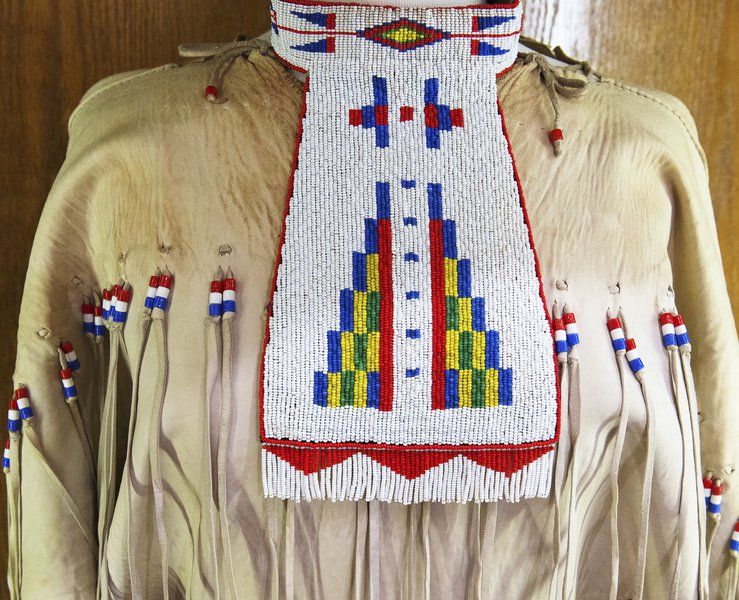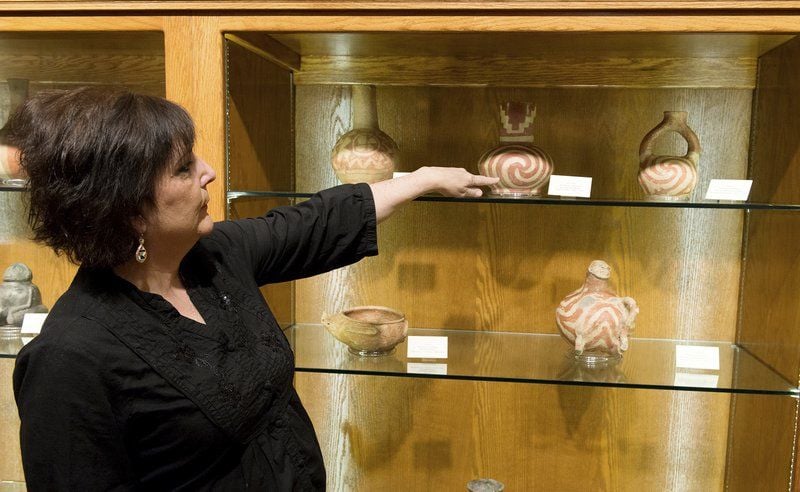Museum tells history of Quapaw people


QUAPAW, Okla. — A tribal museum in this town tells the story of the Quapaw people with exhibits and artifacts, including the tribe’s distinctive red-and-white pottery.
Among museum displays is a dugout canoe, several centuries old, found along the Mississippi River, and an anchor from the USS Quapaw — all that remains of a Navy tug that served during World War II and the Korean and Vietnam wars, earning 17 battle stars. It was decommissioned in 1985 and was dismantled in 2012, but a member of the USS Quapaw Association preserved the anchor.
The Quapaw, originally part of the Sioux nation, at one time lived along the Atlantic coast but migrated westward throughout the centuries. When Hernando de Soto came up the Mississippi River in 1541, he made contact with the tribe, then the tribe had its first contact with Europeans in Arkansas.
Indian lore has it that the Quapaw were once part of the same tribe as the Osage and the Omaha but were separated while trying to cross a flooded river.
The three groups became separate tribes. The Osage once lived north of the Arkansas River while the Quapaw lived to the south.
The tribe moved from Arkansas to the Red River in Texas-Oklahoma after it was expelled from Arkansas in 1824. Some later returned to Arkansas for a few years, but eventually, the tribe was relocated to Northeast Oklahoma.
Through the years, Quapaw intermarried with other tribes, often the Osage, and with Europeans.
Jean Ann Quapaw Blue, who died in 2002 at age 79, was the last female pureblood member of the Quapaw tribe. Robert Whitebird, who died in 2005 at age 92, was the last male pureblood Quapaw, according to tribal records. The building the museum is in — the Robert Whitebird Cultural Center — is named after him.
Tribal historian Ardina Moore, 84, whose grandfather was the last chief of the Quapaw, said about 40 half-blood Quapaw remain. Moore herself is half Quapaw, with a father who was part Osage, part Kaw and part French.
In 1913, lead was discovered in Northeast Oklahoma on the land of Harry Crawfish, a Quapaw, leading to a mining boom. A 1926 map at the museum shows the underground mines.
Another picture shows the enormous piles of tailings, or waste, left from the mining. The area ultimately became part of one of the largest environmental disasters in the United States, the Tar Creek Superfund Site, which the tribe is helping today to clean up. One of the air-monitoring sites for the fund is on the former Whitebird property.
John Berrey, chairman of the Quapaw tribe, has said previously that increased revenue that Northeast Oklahoma tribes now have from casinos and other businesses is aiding them in protecting tribal artifacts and culture. The Quapaw opened its tribal museum in 2010.
The museum has head pots from central Arkansas, which are commonly buried with Indians, and bowls representing animals.
The pottery is often adorned with the Quapaw swirl, which represents four directions. The swirl is also on the sign for the tribe’s Downstream Casino Resort.
“They found Quapaw pottery all over the country because it was such a tradable item,” said Karen Hildreth, the museum registrar.
Betty Gaedtke, who is on the Quapaw business committee, said tribal pottery is easily recognizable because of its red and white colors. She said the head pots look like human heads, sometimes with pierced ears and tattoos. The human effigy bottles commonly have humpbacks.
“I don’t know why,” Gaedtke said.
Others represent animals. There are deer, bears, eagles and crawfish.
“Whatever they saw in nature,” Gaedtke said.
The tribe traditionally cooperated with the Spanish, French and the Americans, but the tribe’s population dropped from between 6,000 and 7,500 in 1541 to an estimated 1,500 to 1,000 by 1805.
Historian Vern Thompson attributed some of that decrease to cheap whiskey introduced by early fur traders. Others died from smallpox. Later, many died during forced removals from Arkansas.
Moore said the Quapaw now number about 4,000.
“I have seen a lot of change during my life,” Moore said. “We came from not knowing much or being educated to our children being educated.”
Wantto go?
The Quapaw Tribal Museum is at 905 Whitebird St., in Quapaw, Okla. Hours are 8 a.m. to 5 p.m. Monday through Thursday, and 8 a.m. to 4 p.m. Friday. Quapaw language classes are also offered in the building each spring and fall.



